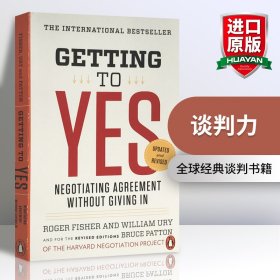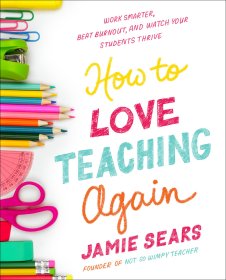
英文原版 Getting to YES 谈判力 英文版 进口英语原版书籍
书籍内容简介可联系客服查阅,查书找书开票同样可以联系客服
¥ 95 ¥ 95 九五品
库存42件
广东广州
认证卖家担保交易快速发货售后保障
作者Fisher, Roger
出版社Penguin Books (TR)
ISBN9780143118756
出版时间2011-05
装帧平装
定价95元
货号YB-1276
上书时间2024-03-17
- 最新上架
商品详情
- 品相描述:九五品
- 商品描述
-
内容摘要
书名:Getting to Yes: Negotiating Agreement Without Giving In 谈判力 作者:Roger Fisher; William L. Ury;Bruce Patton 出版社名称:Penguin Books 出版时间:2011 语种:英文 ISBN:9780143118756 商品尺寸:12.9 x 1.5 x 19.5 cm 包装:平装 页数:224 (以实物为准) 我们每一个人都是一位谈判者,每天都不可避免地要与谈判相伴。虽然谈判随时都在发生,但要谈出好结果却不容易。常见的谈判策略大多属于温和或强硬的方式。温和的方式总是尽量避免摩擦和冲突,为达到共识,往往很快让步;而强硬的方式则以战胜对方为目标,坚守立场,但常会两败俱伤。 还有第三种谈判方式。“哈佛大学谈判项目”研究出了“原则谈判方式”。这种方式根据事情本身的是非曲直寻求解决方案,强调把人和事分开,着眼于利益而非立场,当双方利益发生冲突时,让谈判结果基于某些公平的标准,而不是以某一方意志为转移。 谈判形式千差万别,但基本要素不会变,因此,在各种谈判中,原则谈判方式都完全适用。Getting to Yes《谈判力》便介绍了有关原则谈判的方法。 推荐理由: 1.二十五年来全球经典的谈判书籍; 2. 哈佛大学关于谈判的权威指南; 3.全新修订版,约翰·加尔布雷斯和塞鲁斯·万斯联合推荐。 精彩书评: “这是我迄今为止读到的好的一本谈判指南!无论是维护自身利益的普通人还是致力于维护和平的政治家,都能从这本书中获益。”——约翰·肯尼斯·加尔布雷斯(John Kenneth Galbraith) “已经在国际舞台上大放异彩的简明而有力的谈判理念被带到了大众面前。这本书是处理谈判问题的极佳指南!”——塞鲁斯·万斯(Cyrus Vance) “《谈判力》是一本极具阅读价值、通俗易懂的指南,它可以帮助你解决各种各样的纠纷,教你如何在赢得谈判的同时不失掉友谊。”——安·兰德斯(Ann Lander) The key text on problem-solving negotiation-updated and revised Getting to Yes has helped millions of people learn a better way to negotiate. One of the primary business texts of the modern era, it is based on the work of the Harvard Negotiation Project, a group that deals with all levels of negotiation and conflict resolution. Getting to Yes offers a proven, step-by-step strategy for coming to mutually acceptable agreements in every sort of conflict. Thoroughly updated and revised, it offers readers a straight- forward, universally applicable method for negotiating personal and professional disputes without getting angry-or getting taken. Review “This is by far the best thing I’ve ever read about negotiation.” — John Kenneth Galbraith “The authors have packed a lot of commonsensical observation and advice into a concise, clearly written little book.” —Businessweek “A coherent brief for ‘win-win’ negotiations.” —Newsweek “Getting to Yes has an unrivaled place in the literature of dispute resolution. No other book in the field comes close to its impact on the way practitioners, teachers, researchers, and the public approach negotiation.” — National Institute for Dispute Resolution Forum “Getting to Yes is a highly readable and practical primer on the fundamentals of negotiation. All of us, as negotiators dealing with personal, community, and business problems need to improve our skills in conflict resolution and agreement making. This concise volume is the best place to begin.” — John T. Dunlop “This splendid book will help turn adversarial battling into hardheaded problem solving.” — Averell Harriman One of the key business texts of the modern era. Getting to Yes has helped millions of people learn a better way to negotiate. Based on the work of the Harvard Negotiation Project,a group that deals with all levels of negotiation and conflict resolution. It offers readers a straightforward, universally applicable method for reaching mutually satisfying agreements—at home, in business, and with people in any situation. ReadGetting to Yes to learn step by step, how to: Disentangle the people from the problem Focus on interests, not positions Work together to find creative and fair options Negotiate successfully with anybody at any level 罗杰·费希尔,哈佛大学教授,“哈佛谈判项目”主任;同时供职于冲突管理咨询公司和剑桥冲突管理咨询集团,为众多的政府部门、企业和个人提供谈判咨询服务。 威廉·尤里,国际谈判协作组织顾问,“哈佛谈判项目”创立者之一,曾在哈佛商学院为企业家、工会领导者和政府官员讲授谈判课程。 布鲁斯·巴顿,“哈佛谈判项目”副主任,曾创办过两家致力于谈判培训和咨询的顾问公司。 Roger Fisheris the Samuel Williston Professor of Law Emeritus and director emeritus of the Harvard Negotiation Project. William Ury cofounded the Harvard Negotiation Project and is the award-winning author of several books on negotiation. Bruce Pattonis cofounder and Distinguished Fellow of the Harvard Negotiation Project and the author ofDifficult Conversations, aNew York Timesbestseller. Chapter 4: Invent Options for Mutual Gain The case of Israel and Egypt negotiating over who should keep how much of the Sinai Peninsula illustrates both a major problem in negotiation and a key opportunity. The pie that leaves both parties satisfied. Often you are negotiating along a single dimension, such as the amount of territory, the price of a car, the length of a lease on an apartment, or the size of a commission on a sale. At other times you face what appears to be an either/or choice that is either markedly favorable to you or to the other side. In a divorce settlement, who gets the house? Who gets custody of the children? You may see the choice as one between winning and losing- and neither side will agree to lose. Even if you do win and get the car for $12,000, the lease for five years, or the house and kids, you have a sinking feeling that they will not let you forget it. Whatever the situation, your choices seem limited. option like a demilitarized Sinai can often make the difference between deadlock and agreement. One lawyer we know attributes his success directly to his ability to invent solutions advantageous to both his client and the other side. He expands the pie before dividing it. Skill at inventing options is one of the most useful assets a negotiator can have. Yet all too often negotiators end up like the proverbial children who quarreled over an orange. After they finally agreed to divide the orange in half, the first child took one half, ate the fruit, and threw away the peel, while the other threw away. the fruit and used the peel from the second half in baking a cake. All too often negotiators “leave money on the table”—they fail to reach agreement when they might have, or the agreement they do reach could have been better for each side. Too many negotiations end up with half an orange for each side instead of the whole fruit for one and the whole peel for the other. Why? DIAGNOSIS As valuable as it is to have many options, people involved in a negotiation rarely sense a need for them. In a dispute, people usually believe that they know the right answer—their view should prevail. In a contract negotiation they are equally likely to believe that their offer is reasonable and should be adopted, perhaps with some adjustment in the price. All available answers appear to lie along a straight line between their position and yours. Often the only creative thinking shown is to suggest splitting the difference. inventing of an abundance of options: (1) premature judgment; (2) searching for the single answer; (3) the assumption of a fixed pie; and (4) thinking that “solving their problem is their problem.” In order to overcome these constraints, you need to understand them. Premature judgment Inventing options does not come naturally. Not inventing is the normal state of affairs, even when you are outside a stressful negotiation. If you were asked to name the one person in the world most deserving of the Nobel Peace Prize, any answer you might start to propose would immediately encounter your reservations and doubts. How could you be sure that that person was the most deserving? Your mind might well go blank, or you might throw out a few answers that would reflect conventional thinking: “Well, maybe the Pope, or the President.” pounce on the drawbacks of any new idea. Judgment hinders imagination. sense is likely to be sharper. Practical negotiation appears to call for practical thinking, not wild ideas. On the other side. Suppose you are negotiating with your boss over your salary for the coming year. You have asked for a $4,000 raise; your boss has offered you $1,500, a figure that you have indicated is unsatisfactory. In a tense situation like this you are not likely to start inventing imaginative solutions. You may fear that if you suggest some bright half-baked idea like taking half the increase in a raise and half in additional benefits, you might look foolish. Your boss might say, “Be serious. You know better than that. It would upset company policy. I am surprised that you even suggested it.” If on the spur of the moment you invent a possible option of spreading out the raise over time, he may take it as an offer: “I’m prepared to start negotiating on that basis.” Since he may take whatever you say as a commitment, you will think twice before saying anything. You may also fear that by inventing options you will disclose some piece of information that will jeopardize your bargaining position. If you should suggest, for example, that the company help finance the house you are about to buy, your boss may conclude that you intend to stay and that you will in the end accept any raise in salary he is prepared to offer. Searching for the single answer In most people’s minds, inventing simply is not part of the negotiating process. People see their job as narrowing the gap between positions, not broadening the options available. They tend to think, “We’re having a hard enough time agreeing as it is. The last thing we need is a bunch of different ideas.” Since the end product of negotiation is a single decision, they fear that freefloating discussion will only delay and confuse the process. the second is premature closure. By looking from the outset for the single best answer, you are likely to short-circuit a wiser decision-making process in which you select from a large number of possible answers. 1234567
— 没有更多了 —












以下为对购买帮助不大的评价